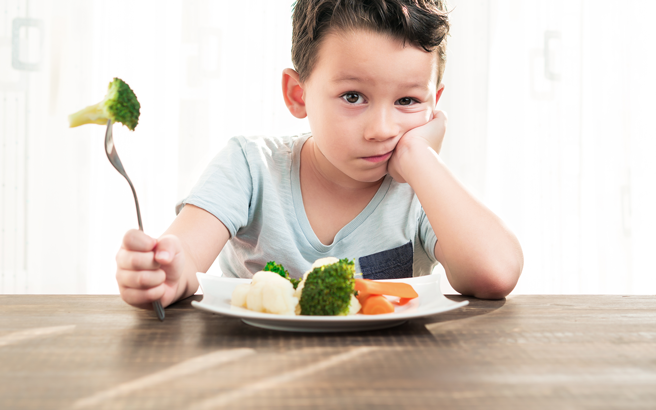 Many children can be fussy eaters, but most will grow out of it as they get older. However, parents and carers can help prevent these habits becoming ingrained. Award-winning baby and child nutritionist Charlotte Stirling-Reed offers advice on feeding fussy eaters.
Many children can be fussy eaters, but most will grow out of it as they get older. However, parents and carers can help prevent these habits becoming ingrained. Award-winning baby and child nutritionist Charlotte Stirling-Reed offers advice on feeding fussy eaters.
> Am I a fussy eater? Check out our Eat Move Learn section to find out!
Repeated exposure
Try to introduce children to a variety of foods at a young age – the earlier the better. It’s really common for it to take a while (sometimes up to 15 times or more of offering a food) for children to accept them. This can be really disheartening and can result in a lot of food waste. However, being really persistent and consistent in your approach can help.
Don’t take rejected foods off the menu – instead, keep trying different foods in different ways and try not to give up. If you can share meals with your children, it means that leftovers don’t get wasted as you can eat them yourself. Just be careful not to eat all your kid’s leftovers, otherwise you’ll end up eating too much!
Punishment and rewards
Should you force your child to eat? Avoid putting pressure on children to eat up certain foods or finish their plates at mealtimes. This pressure can lead to anxiety over mealtimes and can make children even more determined not to eat those foods.
“If you eat all your greens, you can have dessert.” Ever heard that one? This is really common and it’s hard not to use this kind of language around food, as often we’ve grown up with this being the norm. However, what this often causes is a bit of emphasis on food hierarchy – where sweet foods are placed on a pedestal and savoury foods (AKA dinner) are even less desirable.
Instead, if pudding is part of your normal routine continue to serve it even if foods are refused at mealtimes, and try to focus on puddings being nutrient-rich options – such as yogurt and fruit – instead of high-sugar options.
If you want to use rewards or sticker charts, these can be useful, but try to use them for other behaviours too, not just eating. Avoid rewarding children with foods such as sweets, cakes or biscuits, if possible.
Be a role model
Don’t underestimate your power as a role model. Children are heavily influenced by their parents and carers, and by what the grown-ups eat. They often learn what, how and when to eat from watching you so it’s important to eat meals with them as much as possible.
Showing them that you enjoy a variety of foods, including vegetables, can really help – especially if they see you eating them regularly. It’s more likely to become normal behaviour for them this way.
Offer choice
Giving your child choice can help them feel more independent around food. Offering finger buffets or suggesting the choice of X or Y for dinner can really help.
Ultimately, you need to be the one in control of what is on their plates, but allowing them some independence around what parts of the meals they choose can help them feel more in control, and therefore more likely to accept and eat their choices.
You can also try offering choice between healthy options in the supermarket too. Getting children involved in shopping, cooking and serving food can encourage them to be more involved with food at mealtimes.
Food is fun!
Have fun with food – why not bring foods into playtime too? Printing with potatoes, growing your own fruit and vegetables and reading stories about food can help them feel more comfortable around different foods.
If your child is a bit young to be involved in cooking, asking them to taste something and suggest what it needs can help them enjoy food more.
- Check out our healthy family recipes that your children will love.
- Want recipes that children can cook too? We’ve got you covered.
- Check out Eat Move Learn – fun resources and learning activities for children.

